Thursday, May 30, 2013
TOP TEN NEW SPECIES 2013
Lilliputian Violet
(Viola lilliputana)
(Viola lilliputana)
Not only is the Lilliputian violet among the smallest violets in the world, it is also one of the most diminutive terrestrial dicots. Known only from a single locality in an intermontane plateau of the high Andes of Peru, Viola lilliputana lives in the dry puna grassland ecoregion. Specimens were first collected in the 1960s, but the species was not described as a new until 2012. The entire above ground portion of the plant is barely 1 cm tall. Named, obviously, for the race of little people on the island of Lilliput in Jonathan Swift’s Gulliver’s Travels.
Country: Peru

Lyre Sponge
(Chondrocladia lyra)
(Chondrocladia lyra)
A spectacular, large, harp- or lyre-shaped carnivorous sponge discovered in deep water (ave. 3399 m) from the northeast Pacific Ocean off the coast of California. The harp-shaped structures or vanes number from two to six and each has more than 20 parallel vertical branches, often capped by an expanded, balloon-like, terminal ball. This unusual form maximizes the surface area of the sponge for contact and capture of planktonic prey items.
Country: NE Pacific Ocean; USA: California
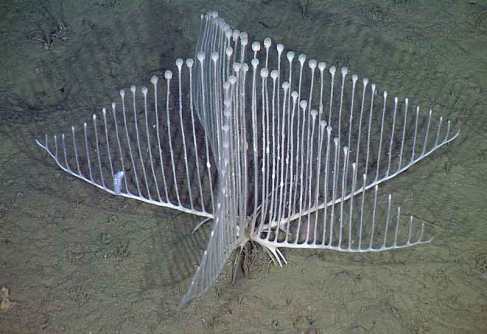
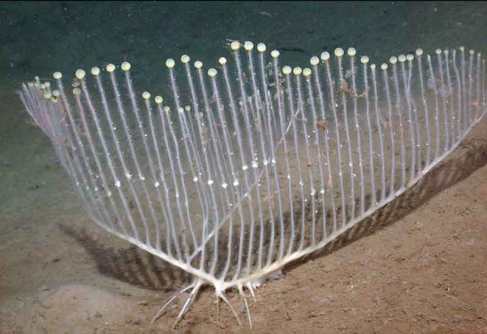
Lesula Monkey
(Cercopithecus lomamiensis)
Discovered in the Lomami Basin of the Democratic Republic of the Congo, the lesula is an Old World monkey well known to locals but newly known to science. This is only the second species of monkey discovered in Africa in the past 28 years, and was first seen by scientists as a captive juvenile in 2007. Scientists describe the lesula as shy having human like eyes. It is more easily heard than seen by the booming dawn chorus it performs. Adult males have a large bare patch of skin on the buttocks, testicles, and perineum that is brilliant blue in color. Although the area where it occurs is remote, the species is hunted for bushmeat and thus its status vulnerable
(Cercopithecus lomamiensis)
Discovered in the Lomami Basin of the Democratic Republic of the Congo, the lesula is an Old World monkey well known to locals but newly known to science. This is only the second species of monkey discovered in Africa in the past 28 years, and was first seen by scientists as a captive juvenile in 2007. Scientists describe the lesula as shy having human like eyes. It is more easily heard than seen by the booming dawn chorus it performs. Adult males have a large bare patch of skin on the buttocks, testicles, and perineum that is brilliant blue in color. Although the area where it occurs is remote, the species is hunted for bushmeat and thus its status vulnerable
Country: Democratic Republic of the Congo
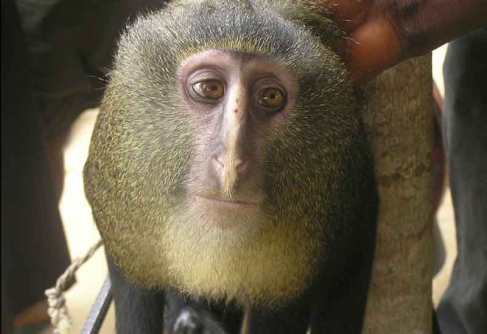

No to the Mine! Snake
(Sibon noalamina)
(Sibon noalamina)
A beautiful new species of snail-eating snake has been discovered from highland rainforests of western Panama. The snake is nocturnal and a predator of soft bodied prey including earthworms and amphibian eggs in addition to snails and slugs. This harmless snake defends itself by mimicking the alternating dark and light rings of venomous coral snakes. Mining of ore deposits in the Serrania de Tabasara mountain range where the species is found is degrading and diminishing its habitat. The species name is derived from the Spanish phrase “No a la mina,” or No to the Mine.
Country: Panama
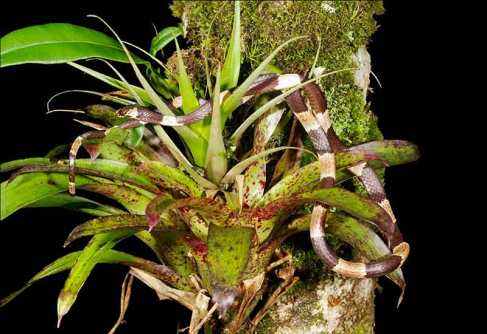
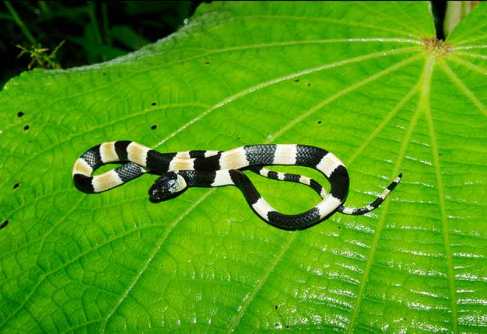
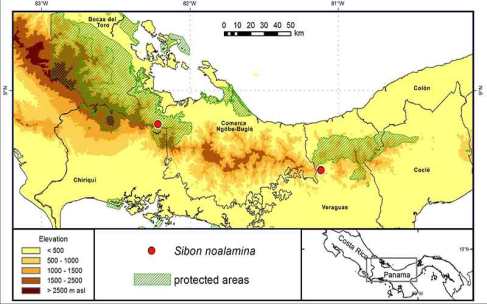
A Smudge on Paleolithic Art
(Ochroconis lascauxensis)
In 2001, black stains began to appear on the walls of Lascaux Cave in France. These stains were so prevalent by 2007 that they became one of the major concerns for the conservation of the precious rock art at the site that dates from the Upper Palaeolithic. A white fungus, Fusarium solani, outbreak had been successfully treated when, a few months later, black staining fungi appeared. The genus Ochroconis primarily includes fungi occurring in the soil and associated with the decomposition of plant matter. While the two new species isolated from Lascaux, are as far as known harmless, at least one species of the group, O. gallopava, causes diseases in immunocompromised humans.
(Ochroconis lascauxensis)
In 2001, black stains began to appear on the walls of Lascaux Cave in France. These stains were so prevalent by 2007 that they became one of the major concerns for the conservation of the precious rock art at the site that dates from the Upper Palaeolithic. A white fungus, Fusarium solani, outbreak had been successfully treated when, a few months later, black staining fungi appeared. The genus Ochroconis primarily includes fungi occurring in the soil and associated with the decomposition of plant matter. While the two new species isolated from Lascaux, are as far as known harmless, at least one species of the group, O. gallopava, causes diseases in immunocompromised humans.
Country: France


World’s Smallest Vertebrate
(Paedophryne amanuensis)
Living vertebrate animals range in size more than 3,000 fold, from this tiny new species of frog as small as 7 mm to the blue whale measuring in at 25.8 m. The new frog was discovered near Amau village in Papua, New Guinea. It claims the title of smallest living vertebrate from a tiny Southeast Asian cyprinid fish that captured the record in 2006. The adult frog size, averaging length of both males and females, is only 7.7mm. With few exceptions, this and other ultra-small frogs have been found in association with moist leaf litter in tropical wet forests suggesting a unique ecological guild that could not exist under drier circumstances.
(Paedophryne amanuensis)
Living vertebrate animals range in size more than 3,000 fold, from this tiny new species of frog as small as 7 mm to the blue whale measuring in at 25.8 m. The new frog was discovered near Amau village in Papua, New Guinea. It claims the title of smallest living vertebrate from a tiny Southeast Asian cyprinid fish that captured the record in 2006. The adult frog size, averaging length of both males and females, is only 7.7mm. With few exceptions, this and other ultra-small frogs have been found in association with moist leaf litter in tropical wet forests suggesting a unique ecological guild that could not exist under drier circumstances.
Country: New Guinea
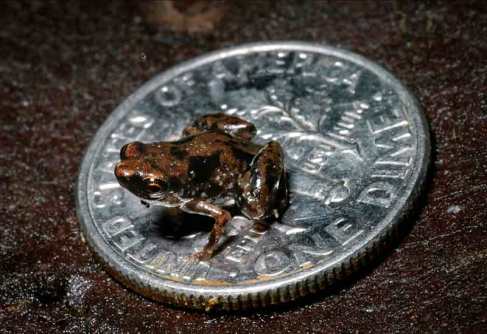
Endangered Forest
(Eugenia petrikensis)
Eugenia is a large, worldwide genus of woody evergreen trees and shrubs of the myrtle family that is particularly diverse in South America, New Caledonia and Madagascar. The new species E. petrikensis is a shrub growing to two meters with emerald green, slightly glossy, foliage and beautiful dense clusters of small magenta flowers. It is one of seven new species described from the littoral forest of eastern Madagascar and is considered to be an endangered species. It is only the latest evidence of the unique and numerous species found in this specialized humid forest that grows on sandy substrate within kilometers of the shoreline. Once forming a continuous band 1,600 km long, the littoral forest has been reduced to isolated, vestigial fragments under pressure from human populations.
(Eugenia petrikensis)
Eugenia is a large, worldwide genus of woody evergreen trees and shrubs of the myrtle family that is particularly diverse in South America, New Caledonia and Madagascar. The new species E. petrikensis is a shrub growing to two meters with emerald green, slightly glossy, foliage and beautiful dense clusters of small magenta flowers. It is one of seven new species described from the littoral forest of eastern Madagascar and is considered to be an endangered species. It is only the latest evidence of the unique and numerous species found in this specialized humid forest that grows on sandy substrate within kilometers of the shoreline. Once forming a continuous band 1,600 km long, the littoral forest has been reduced to isolated, vestigial fragments under pressure from human populations.
Country: New Madagascar

Lightning Roaches
(Lucihormetica luckae)
Luminescence among terrestrial animals is rather rare and best known among certain groups of beetles — fireflies and certain click beetles in particular — and cave-inhabiting fungus gnats. Since the first discovery of a luminescent cockroach in 1999, more than a dozen species have, pardon the pun, come to light. All are rare and, interestingly, so far only found in remote areas far from light pollution. The latest addition to this growing list is L. luckae that may be endangered or possibly already extinct. It is known from a single specimen collected 70 years ago from an area recently heavily impacted by the eruption of the Tungurahua volcano. The species may be most remarkable because the size and placement of its lamps suggest that it is using light to mimic toxic luminescent click beetles.
(Lucihormetica luckae)
Luminescence among terrestrial animals is rather rare and best known among certain groups of beetles — fireflies and certain click beetles in particular — and cave-inhabiting fungus gnats. Since the first discovery of a luminescent cockroach in 1999, more than a dozen species have, pardon the pun, come to light. All are rare and, interestingly, so far only found in remote areas far from light pollution. The latest addition to this growing list is L. luckae that may be endangered or possibly already extinct. It is known from a single specimen collected 70 years ago from an area recently heavily impacted by the eruption of the Tungurahua volcano. The species may be most remarkable because the size and placement of its lamps suggest that it is using light to mimic toxic luminescent click beetles.
Country: Ecuador
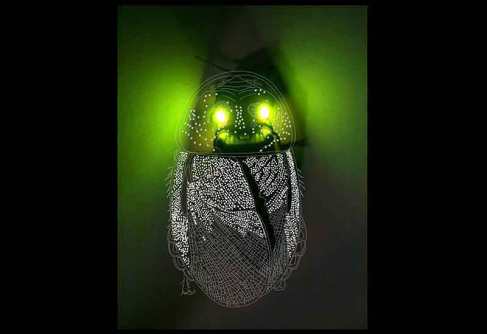
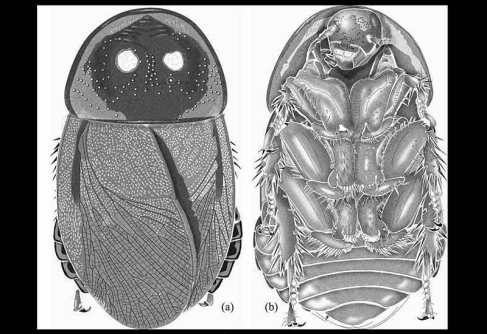
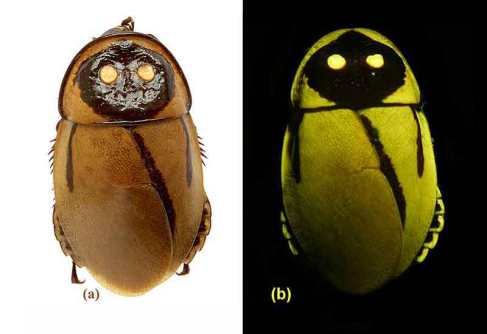
No Social Butterfly
(Semachrysa jade)
In a trend setting collision of science and social media, Hock Ping Guek photographed a beautiful green lacewing with dark markings at the base of its wings in a park near Kuala Lumpur and shared his photo on Flickr. Dr. Shaun Winterton, an entomologist with the California Department of Food and Agriculture, serendipitously saw the image and recognized the insect as unusual. When Guek was able to collect a specimen, it was sent to Dr. Stephen J. Brooks at London’s Natural History Museum who confirmed its new species status. The three joined forces preparing a description using Google Docs. In this triumph for citizen science, talents from around the globe collaborated by new media in making the discovery. It is named, by the way, for Winterton’s daughter, Jade, not its color.
(Semachrysa jade)
In a trend setting collision of science and social media, Hock Ping Guek photographed a beautiful green lacewing with dark markings at the base of its wings in a park near Kuala Lumpur and shared his photo on Flickr. Dr. Shaun Winterton, an entomologist with the California Department of Food and Agriculture, serendipitously saw the image and recognized the insect as unusual. When Guek was able to collect a specimen, it was sent to Dr. Stephen J. Brooks at London’s Natural History Museum who confirmed its new species status. The three joined forces preparing a description using Google Docs. In this triumph for citizen science, talents from around the globe collaborated by new media in making the discovery. It is named, by the way, for Winterton’s daughter, Jade, not its color.
Country: Malaysia
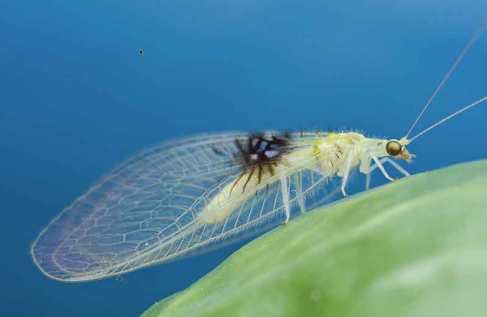

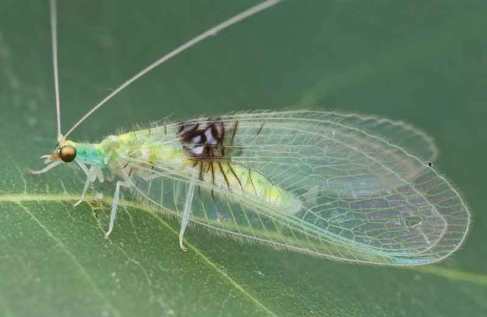
Hanging Around in the Jurassic
(Juracimbrophlebia ginkgofolia)
Living species of hangingflies can be found, as the name suggests, hanging beneath foliage where they capture other insects as food. They are a lineage of scorpionflies charactersized by their skinny bodies, two pairs of narrow wings, and long threadlike legs. A new fossil species, Juracimbrophlebia ginkgofolia, has been found along with preserved leaves of a gingko-like tree, Yimaia capituliformis, in Middle Jurassic deposits in the Jiulongshan Formation in China’s Inner Mongolia. The two look so similar that they are easily confused in the field and represent a rare example of an insect mimicking a gymnosperm, 165 million years ago, before the explosive radiation of flowering plants.
(Juracimbrophlebia ginkgofolia)
Living species of hangingflies can be found, as the name suggests, hanging beneath foliage where they capture other insects as food. They are a lineage of scorpionflies charactersized by their skinny bodies, two pairs of narrow wings, and long threadlike legs. A new fossil species, Juracimbrophlebia ginkgofolia, has been found along with preserved leaves of a gingko-like tree, Yimaia capituliformis, in Middle Jurassic deposits in the Jiulongshan Formation in China’s Inner Mongolia. The two look so similar that they are easily confused in the field and represent a rare example of an insect mimicking a gymnosperm, 165 million years ago, before the explosive radiation of flowering plants.
Country: China
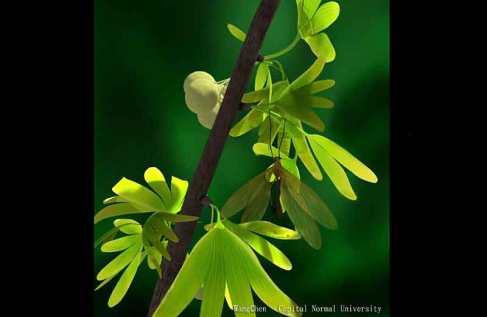

TOP TEN NEW SPECIES 2013
Distribution Map
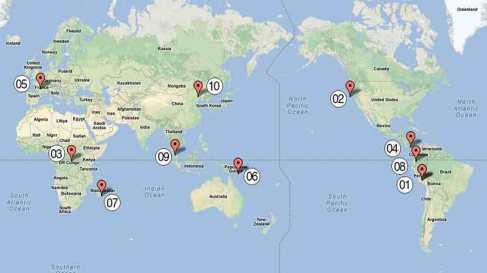
01 — Lilliputian Violet — Viola lilliputana — Peru
02 — Lyre Sponge — Chondrocladia lyra — NE Pacific Ocean; USA: California
03 — Lesula Monkey — Cercopithecus lomamiensis — Democratic Republic of the Congo
04 — No to the Mine! Snake — Sibon noalamina — Panama
05 — A Smudge on Paleolithic Art — Ochroconis anomala, Ochroconis lascauxensis — France
06 — World’s Smallest Vertebrate — Paedophryne amanuensis — New Madagascar
07 — Endangered Forest — Eugenia petrikensis — New Guinea
08 — Lightning Roaches — Lucihormetica luckae — Ecuador
09 — No Social Butterfly — Semachrysa jade — Malaysia
10 — Hanging Around in the Jurassic — Juracimbrophlebia ginkgofolia — China
02 — Lyre Sponge — Chondrocladia lyra — NE Pacific Ocean; USA: California
03 — Lesula Monkey — Cercopithecus lomamiensis — Democratic Republic of the Congo
04 — No to the Mine! Snake — Sibon noalamina — Panama
05 — A Smudge on Paleolithic Art — Ochroconis anomala, Ochroconis lascauxensis — France
06 — World’s Smallest Vertebrate — Paedophryne amanuensis — New Madagascar
07 — Endangered Forest — Eugenia petrikensis — New Guinea
08 — Lightning Roaches — Lucihormetica luckae — Ecuador
09 — No Social Butterfly — Semachrysa jade — Malaysia
10 — Hanging Around in the Jurassic — Juracimbrophlebia ginkgofolia — China
Different Types of Bridges
Below are some of the different types of bridges:
Beam Bridge: A beam bridge is basically drawn from the log bridge. Its construction relies on low steel beams, concrete and box grinders. It is said that the construction of beam bridge is the technically the easiest and uncomplicated among all the other types. Some of the bridges of this type include highway overpasses, flyovers or walkways. In this type of bridge a flat beam is supported on its both ends on piers.
Truss Bridge: This type of bridges is constructed by joining straight elements. These elements are often joined by means of pin joints. There is an abundance of forests in United States and hence of wood as well. Due to this fact, a lot of truss bridges were made in the past with timbers iron rods. Timbers were used as a source of compression and iron rods were used handle the tension. In the course of history, the truss bridges became popular from 1870s to 1930s. One such popular bridge is Deck truss Railroad Bridge constructed on the Erie Canal.
Arch Bridge: Arch bridges are called arch bridge because of having a shape similar to arches. These bridges are normally constructed with weight equally distributed into the ropes or chains at both the ends. The oldest arch bridge that still exists is the ‘Mycenaean Arkadiko Bridge’ constructed in Greece somewhere around 1300BC. Although, Greeks and Etruscans were familiar with the arches, Romans were known to be the first who discover the art of constructing an arch bridge. Present day arch bridge are the modified from as they have become compression arch suspended deck bridge which rely on light but stronger tensile construction material.
Suspension Bridge: A suspension bridge is a bridge that hangs from steel cables which are supported by towers on each end. Technically, the load of the bridge is transformed into the stretchiness in the cables. Some of the popular suspension bridges include the Golden Gate Bridge of United States, the Humber Bridge of England and the Tsing MA Bridge of China.
Cable-stayed Bridge: These are almost similar to suspension bridge in their structure but with few exceptions. The major differences between the two exist in the quantity of steel cable used. In the cable-stayed bridge, the towers used to support cables are relatively shorter and require less amount of cable as compared to suspension bridge. Cable-stayed bridge has two different versions: the harp design and fan variant design. Cables are connected to several points in harp design while in fan variant, the cables are attached to the tower. In United States, Cable Bridge has the reputation of first of this type. Other popular bridge is Centennial Bridge.
Cantilever Bridge: These are the bridges which are constructed in such a way that they stand out in the direction of horizontal-axis in space. These bridges are supported just on one end. The bridges for low traffic are simply based on beams whereas the bridges for heavy traffic are comprised of box grinders or trusses. Two of the most popular cantilever bridges include the Quebec Bridge of Canada (1800 feet long) and Oakland Bay Bridge of Sans Francisco (1400 feet long).
Bridges are surely a great way to reach the places which people never think of by any other simple mean. Bridges not only connect far-off lands but also provide opportunity to the mankind to explore different aspect of new technology. A bridge may be a an inspiration of a man who saw a block of wood floating on a water surface or perhaps the urge to come in contact with people living far-off ends. Whatever the reasons, the bridge is surely a great way to defeat the physical hindrances.
Subscribe to:
Posts (Atom)
